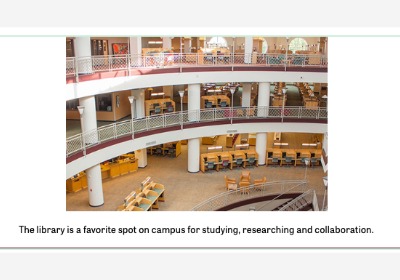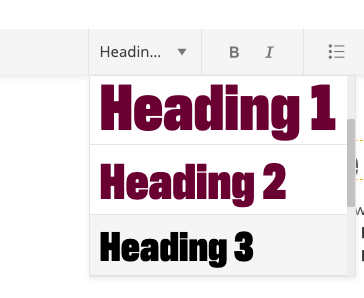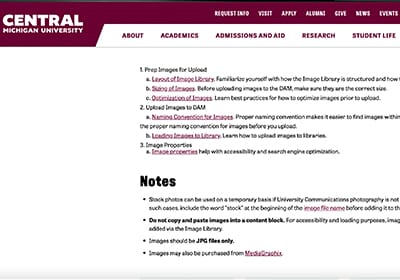
Standards and Best Practices
The CMU website is our highest-visibility resource for sharing our brand personality and services with digital users. Having a unified, consistent, modern web presence is important for the trust of our users and pride of our community. Below are standards for creating and working on CMU pages.
Page titles and headings
Page titles and headings play an important part in Search Engine Optimization and accessibility. While it does affect the page aesthetics, it is critical to use them properly to ensure the page functions correctly.
How you title your pages and headings impacts:
- Search Engine Optimization: Utilizing full titles improves visibility in search engines, making it easier for users to find relevant content related to their searches.
- User experience: Clear and descriptive titles help visitors immediately recognize the content they are accessing, enhancing their overall experience on the site.
- Accessibility: Full titles provide essential context for users relying on assistive technologies, improving navigation and improves the usability for all individuals, including those with disabilities, impairments and physical limitations.

Title and heading tips
- Follow sentence case and avoid punctuation.
- Helpful heading: Preparing to file your FAFSA
- Less helpful heading: Preparing: File Your FAFSA!
- Describe the content literally. Page titles and headings need to be descriptive so they can be easily found on the site and by search engines. Pages such as About and FAQ should include the page topic in the titles.
- Helpful page title: About the Office of Research and Graduate Studies
- Less helpful page title: About
- Helpful H2: Study Abroad frequently asked questions
- Less helpful H2: FAQs
Links
Anchor links are the only links appropriate for headings. Adding a ordinary link to a heading is a violation of accessibility standards. At all other times, links should be used in body text.
When inserting links:
- Do not use "Click Here" as your call to action. Instead, describe what the user will find when they take the action.
- Do not paste a URL directly in to the content. Instead use link properties to describe what the user will find.
Web writing strategy
CMU's brand strategy is supported in part by our brand platform, tone and voice. Consistency in what we say and how we say it helps our brand reputation. See our Brand Platform, Tone and Voice and CMU AP Style Guidelines for tips on how to align your content with the university strategy.
CMU’s AP style guidelines
Looking for something specific and don't see it below? Check out the University Communications Style Guide for an alphabetical list to guide the use of specific words.
Bulleted lists
- Each item in a bulleted list has the first word capitalized.
- A period is added to the end of each item in the case of sentence fragments as brief as two words, but it does not apply to lists of one-word items or personal names.
- The second-to-last bulleted item does not end with “and.”
Phone numbers
- Should be formatted xxx-xxx-xxx.
- Incorrect: (989) 774-4000
- Correct: 989-774-4000
Email addresses
- No hyphen in email or online.
- Incorrect: e-mail and on-line
- Correct: email and online
Dates
- Dates follow the format of Month Day, Year.
- Eg. Jan. 3, 2030.
- A span of years follows this format: 2030-31.
Time
- Per AP style, use lowercase a.m. and p.m.
- For example: 9:30 a.m.
Departments
- Capitalize names of Central Michigan University departments, centers and offices.
Majors and minors
- Names of majors or programs of study are lowercase.
